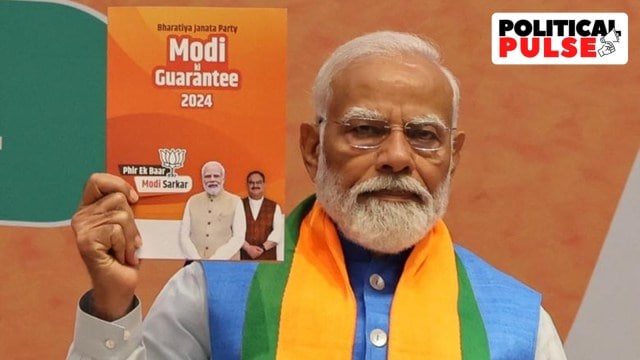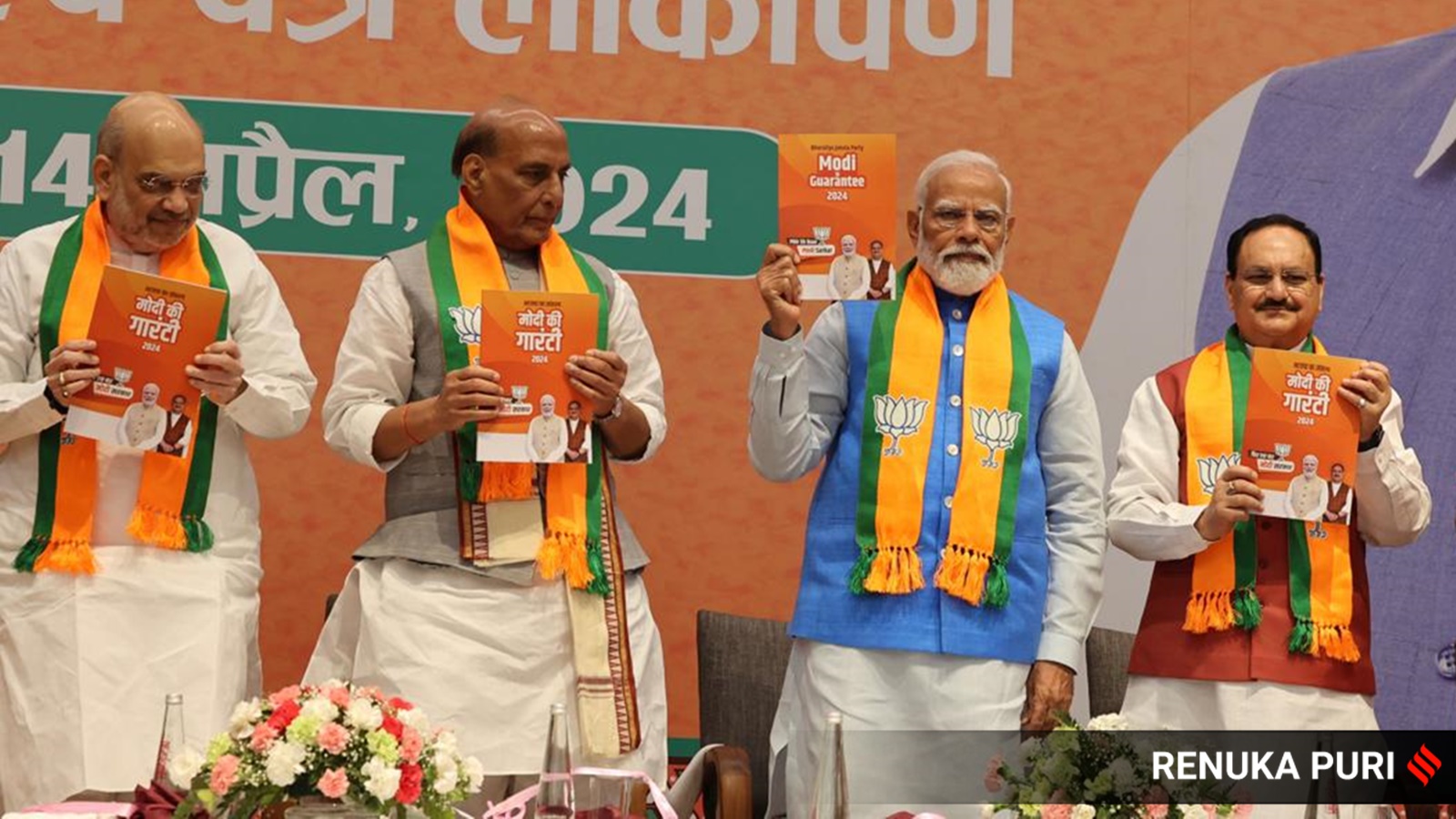Pitching for a third term, with two of its three core ideological projects – abrogation of Article 370 that gave special status to Kashmir and the construction of Ayodhya Ram Temple – completed, the BJP’s “Sankalp Patra” (manifesto) for 2024 is more a re-statement of its governance programme rather than a politically contentious document.
Underlining the shift in “mindset,” from “desperation” to confidence, the manifesto flags that after 10 years in government, the party promises stability and continuity with a continued focus on expanding the welfare net, upgrading public infrastructure and increasing opportunities for all the young, women, the middle-class and the elderly.

The only element of the BJP’s original core agenda that remains is Uniform Civil Code and the manifesto reaffirms that pledge, using the same paragraph from the 2019 manifesto, framing it in terms of gender equality: “…BJP believes that there cannot be gender equality till such time Bharat adopts a Uniform Civil Code, which protects the rights of all women, and the BJP reiterates its stand to draw a Uniform Civil Code, drawing upon the best traditions and harmonising them with the modern times.”
Story continues below this ad
Resolving to implement “One Nation, One Election,” the manifesto promises to expand the government’s flagship infrastructure and welfare programmes, including road, housing, Ujjwala gas connection and Ayushman Bharat health insurance schemes, and announced free electricity for poor households.
 Prime Minister Narendra Modi, Union Home Minister Amit Shah, Defence Minister Rajnath Singh and BJP president J P Nadda unveil BJP’s manifesto on Sunday. (Express Photo)
Prime Minister Narendra Modi, Union Home Minister Amit Shah, Defence Minister Rajnath Singh and BJP president J P Nadda unveil BJP’s manifesto on Sunday. (Express Photo)
“This is the work of the Modi government for the next five years. We have the legacy of the last 10 years, a vision for the next 25 years, so the next five years are very important and significant for us. We will be laying foundations for the next 25 years in this term,” said a senior minister after the launch of the Sankalp Patra in the party headquarters Sunday.
Here is a detailed look at what is missing and what is new.
NRC out, AFSPA in
In the context of dealing with undocumented immigration, the 2019 manifesto said: “There has been a huge change in the cultural and linguistic identity of some areas due to illegal immigration, resulting in an adverse impact on local people’s livelihood and employment. We will expeditiously complete the National Register of Citizens process in these areas on priority. In future we will implement the NRC in a phased manner in other parts of the country.”
Story continues below this ad
The manifesto makes no mention of the NRC. Asked about this, BJP leaders declined to comment.
The manifesto has a significant addition as compared to 2019. Under the section “Maintaining Peace in Northeast”, it says, “We will continue our efforts to address the issues in the disturbed areas and remove AFSPA in a phased manner. We will further work towards resolution of inter-state border disputes amongst Northeastern states through sustained efforts.”
Farmers: no income promise, push on welfare
The 2019 manifesto promised to double farmers’ income by 2022. “At the very beginning of our current term, Prime Minister Modi embarked on a mission to double farmers’ income. We will make all efforts to achieve this goal by 2022,” it said.
The 2024 manifesto skips any such mention. It promises to “further strengthen the PM Fasal Bima Yojana through more technological interventions to ensure speedy and more accurate assessment, faster payouts and quicker grievance resolution” and “continue to increase MSP from time to time”.
Story continues below this ad
Besides, the ruling party has promised to set up new clusters for vegetable production and storage, position India as the “Nutri-Hub of the world”, focus on expanding millet cultivation among small farmers, promote research and international marketing to underscore its health and sustainability advantages, launch the National Mission on Natural Farming to promote nature-friendly, climate-resilient, remunerative agriculture for food and nutrition secure Bharat and further incentivise crop diversification to make agriculture sustainable and remunerative.
The manifesto promises to launch a “Krishi Infrastructure Mission for integrated planning and coordinated implementation of agri-infrastructure projects”, expand irrigation facilities, create a network of grain storage facilities in rural areas, launch an indigenous Bharat Krishi satellite, and expand PM Kisan Samriddhi Kendras.
Ramayan festivals
Reiterating its stand on the Ram Mandir, the 2019 manifesto said, “We will explore all possibilities within the framework of the Constitution and all necessary efforts to facilitate the expeditious construction of the Ram Temple in Ayodhya.”
Now that the temple has been opened, the manifesto vows to preserve and promote the legacy of Lord Ram and says, “Ramayan is celebrated across the world, particularly in South and South-East Asia. We will launch a global outreach program for documenting and promoting the tangible and intangible legacy of Lord Ram in all countries. We will celebrate Ramayan Utsav with great fervour across the globe to commemorate the Pran Pratishtha of Ram Lalla.”
Story continues below this ad
Besides, it talks about undertaking “significant new projects to develop religious and tourist sites inspired by the Kashi Vishwanath corridor model, across the length and breadth of our country.” The manifesto promises holistic development of Ayodhya.
Artefacts and civilisation
Another addition to the manifesto this time is the resolve to “relentlessly work towards bringing back Bharatiya idols and artifacts that were taken away illegally from Bharat”. There is also the promise to “collaborate with countries across the globe to restore and revitalise sites of Bharatiya civilization”.
Minorities
The manifesto says that the BJP government “empowered Muslim women by protecting them from the barbaric practice of Triple Talaq.” The 2019 manifesto said, “We are committed to the empowerment and ‘development with dignity’ of all minorities (Muslims, Christians, Sikhs, Buddhists, Jains and Parsis etc).”
The manifesto this time talks about linguistic minorities, saying, “We will work on the creation of a technology-based system such as Bhashini for preservation/ facilitating translation of languages of linguistic minorities.”
Story continues below this ad
Silence on Kashmir
The manifesto notes that the government revoked Article 370 leading to a “significant reduction in violence in Jammu and Kashmir”. But that is the only mention of Jammu and Kashmir in the document. Addressing a rally in Udhampur last week, Modi promised the restoration of statehood and said “the day is not far” when Assembly elections would be held in the Union Territory.
While promising to abrogate Article 370 and annul Article 35A of the Constitution, the 2019 manifesto talked about making efforts to “ensure the safe return of Kashmiri Pandits” and providing financial assistance for the resettlement of refugees from West Pakistan, Pakistan-occupied Jammu and Kashmir (POJK), and Chhamb.
Expansion of welfare schemes
The manifesto promises to boost existing infrastructure schemes and expand welfare programmes. It promises to “expand the Ayushman Bharat Yojana to cover senior citizens and provide them access to free and quality healthcare, take piped gas programme to all major cities and towns, double the Mudra loan limit to Rs 20 lakh, provide free electricity to poor households under PM Surya Ghar Muft Bijli Yojana and keep up a free grains programme for 80 crore Indians until 2029”.
BJP leaders said the manifesto committee addressed every sector and every section of the community – the group of leaders, led by Union Minister Ashwini Vaishnaw, went through more than 1.5 million suggestions for the manifesto, including more than 400,000 through the NaMo app and over 1.1 million through videos.



 Prime Minister Narendra Modi, Union Home Minister Amit Shah, Defence Minister Rajnath Singh and BJP president J P Nadda unveil BJP’s manifesto on Sunday. (Express Photo)
Prime Minister Narendra Modi, Union Home Minister Amit Shah, Defence Minister Rajnath Singh and BJP president J P Nadda unveil BJP’s manifesto on Sunday. (Express Photo)





























